Kōgō for the Furo

Kami kama-shiki is a pack of 15 textured, thick papers folded in half widthwise twice. These sheets of paper are made of a particular kind of paper that is called dan–shi, 壇紙, altar-paper. Each sheet measures 8.5 x 11.4 sun kane-jaku, or 6.8 x 9.12 sun kujira-jaku. The character tan, 亶, is used in the word dan, 壇, altar, which includes the character to, 土, earth, as in China, the original altars were made of earth.





Modeled after the drumheads of a kotsuzumi called da-men, 打面, hit-face, which are made of leather. The small black trefoils represent the holes for cords to hold the drum together. The drum is struck with the fingers. The square of silk damask fabric is a ko-buku-sa, 古袱紗, old-cloth-gauze, with a pattern of ‘Nichi–getsu’, 日月, Sun-moon, by Kita-mura Toku-sai, 北村徳斎, North-town Virtue-abstain, Kyōto. A kōgō may be displayed in the tokonoma, which is usually displayed on a pack of kami kama-shiki, 紙釜敷, paper kettle-spread.


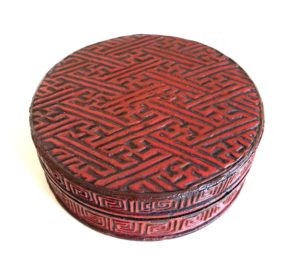

Maru kōgō, 丸香合, round incense-gather; turned wood covered container with impressed red lacquered design of kaminari, 雷, lightning. The pattern of interlocking man-ji, 卍, is an ancient symbol of creation, combining the aspects of In and Yō and turning like the heavens. The pattern is also identified with the warrior monk Ben-kei, 弁慶, Distinguished-joy.


“Hana take ikada kōgō,” 華竹筏香合, flower bamboo raft incense-gather; L. 4.1 sun kane-jaku; by Naka-mura Sō-in中村宗尹, Middle-village Sect-govern; choice of Ryō-ryō-sai, 了々斎, Completion-completion-abstain, IX Iemoto, Omote-sen-ke, 表千家, Front-thousand-family, Kyōto. The reference to hana is for cherry blossoms that fall onto streams, and cluster together making little floating rafts.
The design construction of the incense container, with its eleven pieces of bamboo, may have been inspired by a collection of Chinese poems, in Japanese called, ‘Jiao-jing-yuan Zi-shu’, 题僧院 紫竹, Question-monk-monastery Purple-bamboo. Ryōryōsai was exceedingly fond of poetry. The poems are collectively called Take Jū-ichi–shu, 竹十一首, Bamboo Ten-one-poems. It is a series of eleven poems on bamboo at the temple by Chen Tao, 陈陶, (Japanese – Chin-tō, 陳陶, Explain-ceramic, (824-882); a celebrated late Tang poet. The poems were written about the bamboo grove at the Dong-lin-si, 東林寺, East-woods-temple, that is a Buddhist monastery in the Jiangxi province, China, founded in 386 by Huiyuan, founder of the Pure Land Sect of Buddhism.

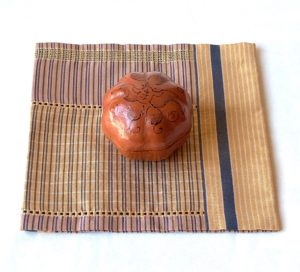

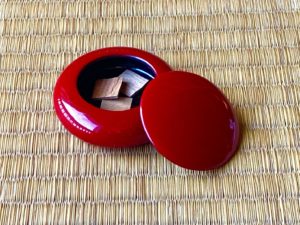
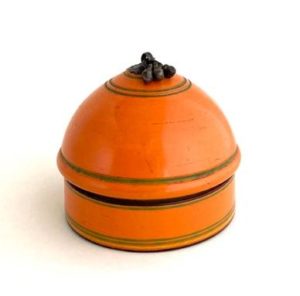

Turned wood covered container with dome-lid and metal bells and with orange lacquer exterior and green lacquered interior; diam, 7 cm, India. Container, kumkum, for tikka, powered red ink or jewel patches to adorn the forehead.

Toothpicks in former times were made of small twigs of willow, yanagi, 楊, as the willow has healthful benefits. A toothpick is an essential possession of a Buddhist monk. The piece is decorated with a gold-leaf design of a sprig of nan-ten, 南天, south-heaven, nandina: the word nanten is wordplay on nan-ten, 難転, difficulty-turn around.
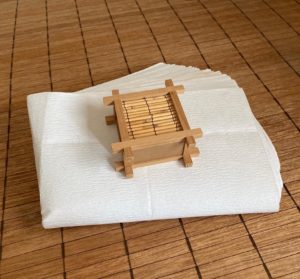
The pictured pack of paper ‘envelopes’ is used as a kami kama-shiki, 紙釜敷, paper kettle spread. The size of a sheet of kami kamashiki is 5.5 x 11 sun kane-jaku; the size of a sheet of shūgi-bukuro paper is 8.8 x 13 sun kane-jaku. Depending on the locale, the shūgi-bukuro paper is folded squarely or diagonally: in the Kyōto area the paper is folded diagonally.

The Kōgō Buddha is a talisman that is also called a ‘Buddha in the pocket’ because it was put in the pockets of travelers in the Edo period. Many people still use it as a talisman. It consists of a lid and a body, and when opened, the guardian deity appears.


